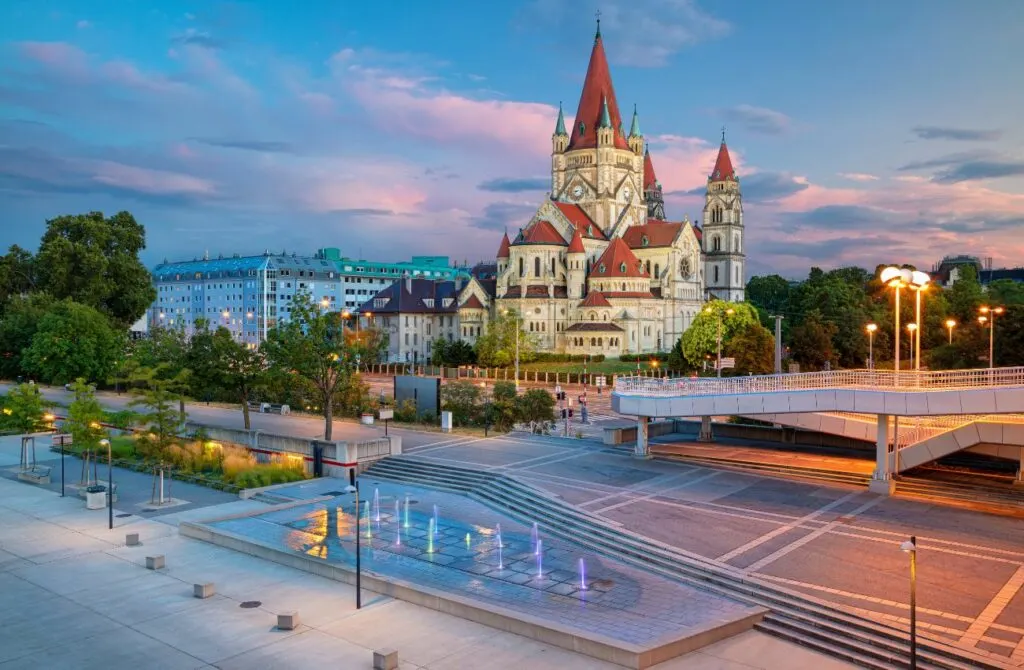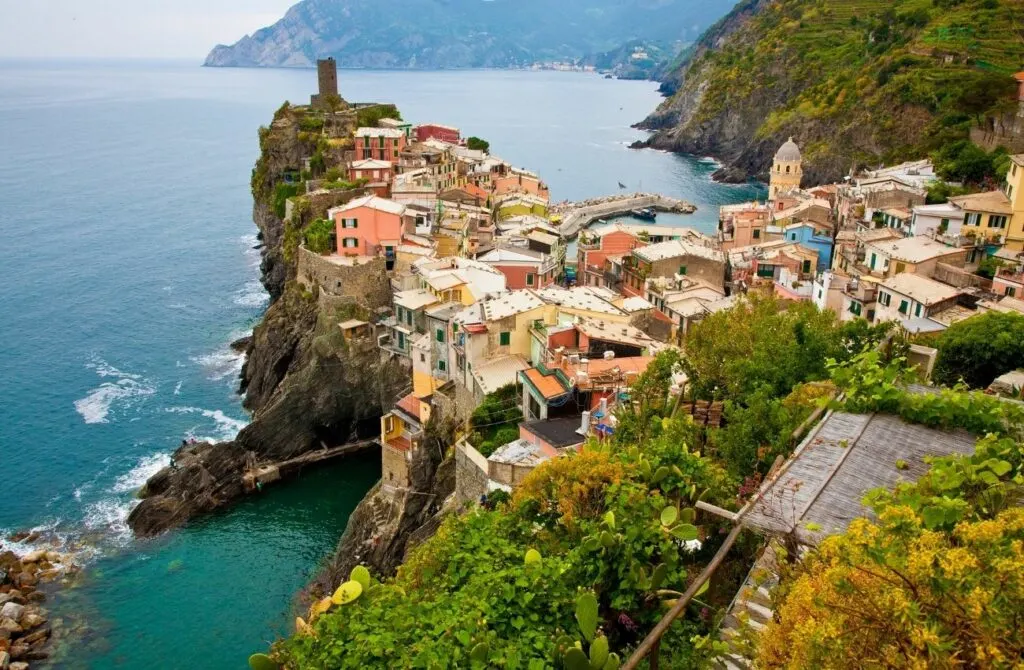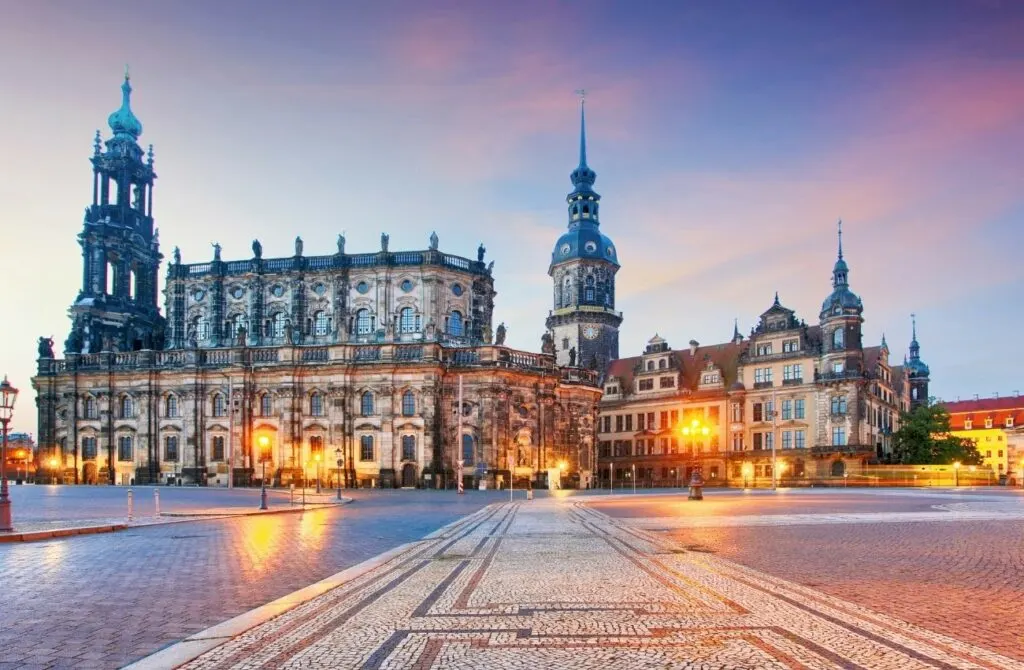Sofia De Vera combines a heartfelt passion for cinema with over 15 years of critiquing for esteemed film publications, wielding academic credentials from the University of Southern California and New York University, to serve as your personal guide through the enchanting worlds of film and television. Her full guest bio can be found here.
Europe has a lot to offer both national and international filmmakers with exquisite natural and urban landscapes, a rich cultural tapestry – and various state-organized film tax credits and incentives programs. So it will come as no surprise that there are so many unforgettable movies set in Europe...
If there’s one place that has been historically venerated and looked up to by the whole world, it’s Europe. The birthplace of most of the things that we think of as the best humanity has to offer: cuisine, arts, architecture, philosophy and science.
What makes Europe so special is the fact that such a wide array of cultures, each of which has so much to offer, have lived in close proximity to each other. This has made Europe a boiling pot of ideas and traditions, all of which have taken different forms in different countries. In sum, it’s a place worth exploring.

And what better way to explore the birthplace of something so wonderful as cinema, than through movies? These films will take you all around Europe, from its most popular spots to some of the most unknown. Like the continent’s history, some of them are happy, some are sad, and some are just plain unique. Even after years and years of writing about Europe, there are things that words just can’t capture. That’s what cinema is for.
Watching a good movie is the best way to get inspired and choose your next destination. It is the reason we have assembled various lists of the best films shot in some of our all-time favorite travel destinations: Barcelona, Dubai, South Africa, Thailand, and New York City (among others). There are things that a photo alone can’t capture. We are human, and we need movement: the waves crashing against a crowded Riveria beach, the mist creeping into a mountain valley, and people walking side by side through a historic medieval town.
These are things that are better experienced with movement. These are things that belong in movies. And these things can be found in Europe.

The films in this list of movies set in Europe paint a picture of a complex region filled with gorgeous sights and diverse voices – yet a deep history and frequent conflict. With this, we hope to help audiences step into the often-contradictory world of Europe and experience the scenery, subcultures, and different dynamics that make Europe what it is today.
Be forewarned that not all of these films are happy – tragedies and misery are as unavoidable in cinema as they are in life – be we promise that each one provides panoramic vistas and thought-provoking narratives from this tantalizing country…
Wondering where to watch? It depends on where you live in the world and which streaming services you have. We link to the streaming service we watch on in each case - be it Netflix, Amazon Prime, Apple TV+, or elsewhere.
You can get one month free of Amazon Prime (or a 6-month trial for students) of Amazon Prime and also get immediate access to FREE Two Day shipping, Amazon Video, and Music. While you won't be charged for your free trial, you'll be upgraded to a paid membership plan automatically at the end of the trial period - though if you have already binged all these, you could just cancel before the trial ends.
Apple TV+ also has a one-week trial, and Hulu has a one-month trial (which can be bundled with Disney!). Another option might be using a VPN to access Netflix titles locked to other regions. Netflix is now available in more than 190 countries worldwide and each country has a different library and availability. US Netflix is (understandably) one of the best.
While we wish everything could just be in one place - for now, it seems these are the best streaming platforms to watch on.



Page Contents
- Det Sjunde Inseglet (1957)
- La Dolce Vita (1960)
- Angst Essen Seele Auf (1974)
- Elle (2016)
- Dogville (2003)
- Los Santos Inocentes (1984)
- Canino (2009)
- Kauas Pilvet Karkaavat (1996)
- Ladri Di Biciclette (1948)
- Dr. Strangelove or: How I Learned to Stop Worrying and Love the Bomb (1964)
- The 400 Blows [Les Quatre Cents Coups] (1959)
- A Good Year (2006)
- All About My Mother [Todo sobre mi madre] (1999)
- Pan’s Labyrinth [El laberinto del fauno] (2006)
- Good Bye, Lenin! (2003)
- Jojo Rabbit (2019)
- Cinema Paradiso [Nuovo Cinema Paradiso] (1988)
- Before Sunrise (1995)
- The Sound Of Music (1965)
- Once (2007)
- In Bruges (2008)
- Braveheart (1995)
- Pride & Prejudice (2005)
- Mamma Mia! (2008)
Det Sjunde Inseglet (1957)
Det Sjunde Inseglet / “The Seventh Seal” is a 1957 film written and directed by Swedish author Ingmar Bergman. It is considered a classic within film culture and one of the films that established Bergman as one of the most acclaimed and influential filmmakers in film history.
It tells the story of Antonius Block, a knight who returns to Sweden after fighting in the crusades, to whom Death appears; Block challenges her to a game of chess, betting on her life. During breaks in his game, he continues to travel with his squire, observing how the Black Death epidemic has terrified the population and meeting various characters along the way: a painter who makes frescoes depicting the Dance of Death, Jof, an itinerant theater actor who travels with his wife and son, a girl condemned to die on the stake for satanic practices, a theologian who now dedicates himself to usurping the dead victims of the plague and a group of flagellates who march through the villages announcing the end of the world, the punishment of the Plague that God has imposed among others.
Ingmar Bergman’s cinema is characterized by always being deep, technically masterful, and intellectually stimulating. We will hardly be able to find a film among his extensive filmography that does not manage to remain engraved in our memories.
La Dolce Vita (1960)
There are three great turbulent forces in life, which manifest as an attractive whirlpool that traps human beings in chaotic spirals. In traditional Christian symbology, somewhat discredited by modernity, they are the devil, the world and the flesh, the three enemies of man: the malice of licentious reasoning, the attraction of riches and material things, and the sweet enchantment of overflowing sexual energies.
When you live under the attraction of these forces, you enjoy la dolce vita, a space without compromises, in which the severe admonitions of normality do not apply, since you live according to the moment, with a full disposition to take advantage of opportunities, without paying much attention to the consequences.
We all carry those dolce vita instincts within us, albeit restrained by social norms and fears of public performance, of making a fool of ourselves. Federico Fellini has shown in his famous film La Dolce Vita what is experienced during a series of frenetic days and nights, in which everything that can happen to a person who allows him to be dragged by the whirlpools of life happens.
Angst Essen Seele Auf (1974)
Angst Essen Seele Auf is one of the most representative films of the German filmmaker Rainer Werner Fassbinder and, therefore, of the new German cinema, the renovating current that was installed internationally from the 60s of the 20th century, and that had an important repercussion in Germany, to
Despite the fact that many of the films made in that country have had a much smaller distribution compared to that of other European cinematographic movements, such as the Nouvelle Vague or the New Italian Cinema. The film is inspired by a film by Douglas Sirk, All That Heaven Allows (1955), in which the protagonist, played by Jane Wyman, fell in love with her gardener, played by Rock Hudson, although in reality, the filmmaker himself admitted that he had shot the film in medias res of other more important works. The film won the Jury Prize at the 1974 Cannes Film Festival.
Fassbinder himself wrote the script, as we have already said, based on the aforementioned film by Douglas Sirk. The action of the film takes place in the Germany of an economic miracle, and the protagonist of the film is an old woman, played by Briggite Mira, who one day meets an immigrant from Morocco of a much more humble social class than the actor plays, El Hedi ben Salem.
The relationship between the two will begin to emerge, and how could it be otherwise in a film directed by the German, the entire community, with dramatic consequences, will mock them.
Elle (2016)
Paul Verhoeven and Isabelle Huppert star in a wonderful performance directing the film. And she will not leave you indifferent.
Michèle is raped in her house. After the assault, she cleans up the scene and gets on with her life. With this beginning, you can imagine that Elle is a movie that leaves no one indifferent, something that goes in her DNA. While preparing it, the director, Paul Verhoeven, wanted to do something “completely different” from what he had done before, and, although he wanted a 100% American film, at least the protagonist and the locations, he did not get it because it was considered immoral. The American public was not prepared for what Verhoeven had in mind.
In 2014, during the Cannes festival, it was described as an “extremely erotic and perverted” film and needed an actress to match. Nicole Kidman, Julianne Moore, and Carice van Houten were saying no to one project after another until Isabelle Huppert arrived, who accepted immediately. “She had no doubts about the integrity of the role. She is a very interesting character because she always goes against the predictable definitions of what it means to be a woman or what it means to be a man,” the actress told NPR.
Upon its release in 2016, critics openly praised it, and, unanimously, Huppert’s performance was considered the best of the film. As for the plot, as Catherine Bray wrote for Time Out, “it’s going to spark debate for decades to come.” There were those who saw it as an empowering film and a magnificent way to tell a story of rape and revenge, but also those who thought the opposite.
Dogville (2003)
Dogville shakes the viewer from the beginning, from the presentation of the town that gives the film its title, revealing an extremely minimalist setting more typical of a play. There is hardly any decoration or props, the limits of the houses are marked with white lines, without walls, and there are signs on the ground that provide information about the houses, where there is supposed to be a bush or a dog.
This unusual approach to the staging, which will be accompanied by the use of a handheld camera, with free and sometimes chaotic movements, seems to have the objective of distancing the viewer from the fiction that is being represented in the style of Bertolt Brecht, of making them aware at all times of the artificiality of the story, and force an analysis of the text, a reflection on the behavior of the characters (and their translation to the real world).
Another peculiarity of the film is its fairytale appearance. The pleasant voice of the narrator (John Hurt) presents the story, the place, and the characters as if it were a children’s story about hard-working and honest people who in bad times receive a gift practically from heaven – there are elements that lend themselves to religious reading.
Even so, from the beginning, it is anticipated that everything will end in tragedy; throughout nine chapters (and a prologue), we will abandon a naive and optimistic Frank Capra-style tale to enter a terrible and devastating parable about human nature. Grace (Nicole Kidman) is a mysterious stranger in Dogville who is wanted by both the mob and the police. The town, led by a young writer and philosopher (Paul Bettany), agrees to help her in exchange for the woman working for them.
Los Santos Inocentes (1984)
Los Santos Inocentes directed by Mario Camus, is a brutal rural drama that convulsed the history of Spanish cinematography in 1984.
At the end of May of that same year, a big story broke in the Spanish media. In it, it was communicated that Alfredo Landa and Francisco Rabal had obtained an award that would change their lives. It was the Best Male Performance Award at the Cannes International Film Festival.
The Spanish writer Miguel Delibes signed one of his best novels in 1981. Three years later, it was adapted to the cinema by the filmmaker Mario Camus who, in my opinion, made the best film of his entire career. It is continually said that the film adaptations of the novels to the big screen leave a lot to be desired, and sometimes it is true. In this case, the film is so big that it may be above the literary work itself, a feat rarely seen in the cinema.
Los Santos Inocentes is a stark portrait of the backward Spain of the 1960s. In the Iberian country, at that time, some behaviors were more similar to the Middle Ages than to a situation typical of the 20th century. The story tells us about the life of a peasant couple and their children. The family works in a farmhouse in Extremadura under the orders of some latinfundistas of the time. The latter treat their workers as if they were animals, using fear as a weapon to control them.
Canino (2009)
Greek cinema is not exactly very lavish in titles that cross borders, at least today. But if there is one that has achieved it and with it, has become a praised and applauded film that leaves no one indifferent that is Yorgos Lanthimos’s ‘Canino.’
That after going through several festivals with notable success (Cannes, Sitges,…) and winning some awards, it came the billboard converted into an original bet, visually impressive, hard but stimulating, and full of questions that the viewer will take with them after the projection.
This is not an easy movie. One of those in which one lets oneself go with relaxation. He doesn’t pretend to. ‘Canino’ takes us to an underworld, to an isolated universe, to the bosom of a middle-class family with three children who live far from the outside world and its influences. Two daughters and a son are leaving adolescence and are physically mature but far removed from what is usual for people living in an influential environment.
An allegory directed with skill and self-confidence by Yorgos Lanthimos, in which echoes of Buñuel can be seen but also of Lynch or Haneke. Overwhelming images, scenes of violence and explicit sex, shot with great simplicity that tears any resemblance to placidity. Some scenes play with the most recalcitrant surrealism (the musical number is surprising), but they give rise to sublime moments that highlight its allegorical dimension, of a risky fable, but original for a story that, despite containing that surreal tone, we can well find ourselves in the news of any newspaper in any corner of the world.
Yorgos succeeds in giving the film a tone of enormous simplicity, with a simple but forceful staging. Fixed shots, no soundtrack, letting the daily chapters of this peculiar family drag us to their mission: not to leave us indifferent. They are addressing issues such as communication, family, innocence, education, and degradation that fly over the entire footage.
Kauas Pilvet Karkaavat (1996)
With his trademark irony and quirky sense of humor, filmmaker Aki Kaurismäki in Kauas Pilvet Karkaavat / “Drifting Clouds” tells the story of a married couple whose marriage and personal pride are tested by life’s hard knocks. As is often the case in Kaurismäki’s films, his characters are ordinary human beings, victims of twists of fate.
The couple is not used to taking risks and lives in a simple apartment in one of the many rental buildings. Ilona loses her job as a waitress at the Dubrovnik restaurant in Helsinki. Shortly after, she finds out that her husband Lauri has been fired from his job as a tram driver for a month. After a series of humiliations and defeats that lead the couple to a situation of strict survival, a kind of rainbow in the lives of both leaves us with a certain confidence in the modest hopes and aspirations of the working class.
At this time when job loss has become a universal threat, Kaurismäki has made a film of profound social significance that is also moving. And as always, what saves the cinema of this director, so faithful in his portrayal of the dark details of the misfortune of his protagonists, is that unique ability to retain a sense of humor, even in the most crushing moments of life.
Ladri Di Biciclette (1948)
People have the tendency to interpret reality according to existing mental schemes. We respond to situations by moving, the images are the cause of the movement, and all this is linked in a realistic way, which can be interpreted through established mental schemes.
The cinema does not escape this reactive chain and tends to be a topical cinema, an action cinema, in which the spectator reacts to the story that is told, moved by the images. Just as there is an optical mechanism that softens the disconnection between images and interprets them visually as a continuous action, so the mental scheme pre-constructed in the minds establishes the meaning of the topics and adjusts them to the existing mental images and interpretations.
But the everyday reality is very surprising if you look at it from a different point of view, more focused on the pure image and not so much on the automatic response that it suggests. Filmmakers, like painters, writers, and musicians, know this and have been playing, more and more daringly, with these spaces. One of these approaches is that of neorealism, which, quoting Bazin, is “a new form of reality, supposedly dispersive, elliptical, wandering or oscillating, which operates in blocks and with deliberately weak links and floating events”. Instead of representing an already deciphered reality, neorealism aimed to deal with ambiguity.
Ladri di biciclette / Bicycle Thieves is considered a classic of neorealism. In this beautiful work by Vittorio De Sica, the story of Antonio is told, a humble character in post-war Italy, who suffers the theft of his work bicycle, an object obtained with great sacrifices, thus losing his chances of bringing sustenance to the home.
His son, a tender and sensitive boy, matures by force in the company of his father, while he tries in vain to recover his bicycle. De Sica has masterfully crafted this simple story, the daily bread of poor people, creating impacts on the viewer, forcing them to ask themselves questions and decipher the complex realities faced by the unemployed and the marginalized.
Dr. Strangelove or: How I Learned to Stop Worrying and Love the Bomb (1964)
After the scandal caused by ‘Lolita’ (1962), Stanley Kubrick stayed in England, ready to face what would be his next film, which would bear the delirious title of ‘Dr. Strangelove or: How I Learned to Stop Worrying and Love the Bomb‘.
Based on the novel ‘Red Alert’ by Peter George speculates on the nuclear threat in times of the Cold War; the 1960s had just begun, and the Cuban missile crisis kept American society aware of what was happening during the War from Vietnam would soon become part of that society. Thus, the fear of a nuclear war was something palpable in the USA and the one that more and the one that less had its own atomic shelter. They were times of fear and uncertainty, and of course, the cinema echoed it.
In 1964, the year the film was produced, another renowned director, Sidney Lumet, was preparing Fail-Safe, based on the novel by Eugene Burdick and Harvey Wheeler, in which Peter George also collaborated on the screenplay, helping Kubrick and Terry Southern to write the script for Dr. Strangelove or: How I Learned to Stop Worrying and Love the Bomb.
As both novels had quite a few elements in common, Kubrick filed a plagiarism lawsuit, fearing that his ideas might be copied. In the end, the thing came to nothing, and Columbia, the distributor of both films, separated the premieres several months apart so as not to confront them. To this, we must add that ‘Boundary Point’ is a serious film, while Kubrick’s transformed George’s novel into a satirical comedy.
Dr. Strangelove or: How I Learned to Stop Worrying and Love the Bomb begins when General Jack Ripper puts the base he is in on alert while giving the order to all the bombers that safeguard the security of the country of heading to Russia to bomb it. Soon the president of the United States is notified of the threat that is being poured over his country, since in the event that Russia is attacked – there is less than an hour left for the bombers to be detected by Russian radars – they have a known weapon as the Ultimate Weapon, whose use would mean the end of humanity.
They have very little time to avert catastrophe as they try to understand how they got to this point. A theme of an almost terrifying seriousness that in the hands of Kubrick manages to make us laugh a few times, but with a bitter aftertaste.
The 400 Blows [Les Quatre Cents Coups] (1959)
This classic French New Wave film was the directorial debut of one of France’s best filmmakers: François Truffaut. The 400 Blows tells the story of Antoine Doinel (Jean-Pierre Léaud), a rebellious teenager who is having trouble finding his place in the world.
Neither his parents nor his teachers understand him. That’s why he always finds himself running away, wandering the streets of Paris alone. The film sees Antoine being sent to a juvenile observation center, which he also runs way from.
Considered one of the best French films ever to be made, The 400 Blows is still a captivating film. The film still feels relevant to this day in its depiction of adolescence. As Antoine runs away from everyone who tries to control him, we get to experience France with him: from Champs Elysées, the famous parks in the center of Paris, to the Elysée’s Palais de Chaillot, which is featured on one of the most iconic shots of all cinema.
Even the Eiffel Tower makes an appearance. The movie ends with Antoine visiting the sea, which he always had wanted to do, and walking through the windswept sands of Villers-sur-Mer.
A Good Year (2006)
A Good Year, by Ridley Scott, takes place in a dream-like vineyard estate located in Provence, one of France’s most popular spots. Every summer during his childhood, Max (Russel Crowe) stayed in this vineyard with his Uncle Henry.
There they lived life in a simple way and Max was happy. But as an adult, Max has become a businessman who’s obsessed with work. When his uncle dies, Max inherits the property. At first, he intends to sell it. He visits the place to check how has it changed with time, but it’s then that finds himself unable to depart with it. Staying for a little while in Provence, Max will fall in love and become a completely different person than he was before.
A Good Year sees this workaholic man rediscovering his values and finding a better life for himself. This film does a great job of showing how certain locations can have an enormous impact on us. It also achieves an amazing portrayal of the French countryside, which often feels like something out of a fairy tale.
Some of the most charming places in Europe are here, from the picturesque villages to the sprawling vineyards, it’s truly dreamlike. And this is one of those magical movies set in Europe that will make you want to visit them all.
All About My Mother [Todo sobre mi madre] (1999)
With All About My Mother, Pedro Almodóvar established himself as one of the best Spanish filmmakers ever. This film deals with several complex issues but it manages to tell its story in such a captivating way that you’ll find yourself unable to look away from the screen. After its commercial and critical success, it’s no surprise that this masterpiece won the Academy Award for Best Foreign Language Film, among many others.
All About My Mother is the story of Manuela (Cecilia Roth), an Argentinian nurse living in Madrid whose life is thrown into disarray. On his 17th birthday, his son Esteban (Eloy Azorín) dies after being hit by a car. Devastated, Manuela quits her job and decides to travel to Barcelona, where her son’s father lives. We then learn a secret Manuela had kept for a long time: she had never told Esteban who his father was, and neither had she told Esteban’s father that he had a son.
That’s because his father was Lola, a transgender woman of who Manuela was ashamed. In Barcelona, Manuela reconnects with her colorful friends from adolescence, who will help her go through this trying time.
Pan’s Labyrinth [El laberinto del fauno] (2006)
From the mind of Guillermo del Toro, the Mexican filmmaker behind The Shape of Water, comes this acclaimed dark fantasy story that is sure to make you feel chills.
Pan’s Labyrinth is a story about a girl named Pan who finds a mythical place hidden inside an abandoned labyrinth somewhere in Spain. Even though this place is very scary, she still prefers to escape there every chance she gets, since her life at home is truly terrible: her mother has married a fascist and Pan is forced to live with him and his military troop.
Pan’s Labyrinth is set in Navarra during the end of the Spanish Civil War. In case you’re not familiar, Spain went through a brutal war when fascism arose. Its result was the establishment of a fascist regime in the country, which then led to Spain being Germany’s ally in World War II.
Therefore, the film is surrounded by tragedy: that which happened before, and that which will happen after. Perhaps that’s why it’s such a good fairy tale: as Pan escapes into the fairyland, the troubles in the country are left behind, and she has a chance to be happy.
Good Bye, Lenin! (2003)
Good Bye, Lenin!, by Wolfgang Becker, is one of the best movies set in Europe and tragicomedies ever made. With a hilarious yet thoughtful premise, the film does a great job of balancing its themes and tones.
Set in Berlin in 1989, the film tells the story of Alex (Daniel Brühl) and his mother (Katrin Sass), who fall into a coma just before the Berlin Wall falls and communism in East Germany collapses. When she awakes, eight months later, the doctor warns Alex that they should avoid any stress in her life. The problem is that his mother was a strong supporter of communism. That’s how Alex finds himself concealing the fall of German communism any way he can.
Good Bye, Lenin! is a truly Berliner film. You’ll get to see some of the most iconic sites in the city. Most of the film takes place in Karl-Marx-Allee, a gorgeous boulevard that was clearly built during the times of communist Germany. There are also several scenes in Alexanderplatz, the public square that’s the center of everything that happens in the city.
Perhaps the most known sight in Berlin is the Berliner Fernsehturm, a television tower that can be seen from anywhere in the city.
Jojo Rabbit (2019)
Jojo Rabbit, by Taika Waititi, is the funniest film you’ll ever see about World War II Germany. The film loosely adapts a book from 2008 called Caging Skies, written by Christine Leunens. For this adaptation, writer and director Waititi won an Academy Award for Best Adapted Screenplay.
Set in the height of Nazism, the film tells the story of Johannes “Jojo” Betzler (Roman Griffin Davis), a young German boy who is a fanatic due to the indoctrination at the Hitler Youth organization. He doesn’t quite understand what Nazism stands for, having just a vague idea of who to love and who to hate. Like many other kids, Jojo has an imaginary friend: a whimsical version of Adolf Hitler (played by the film’s director). When Jojo finds a Jewish girl hiding in his attic, his whole outlook on life begins to change.
While the film is mostly humoristic, the setting is not forgotten. The German city where Jojo lives is not named, but it bears quite a resemblance with the archive from that time. In fact, Germany still has some towns which still preserve their picturesque 1930s look. All in all, Jojo Rabbit is without a doubt one of the most charming movies to be released in recent years.
Cinema Paradiso [Nuovo Cinema Paradiso] (1988)
This classic of Italian cinema not only charmed critics and audiences alike, but it’s also credited with revitalizing Italy’s then-stagnant film industry.
Cinema Paradiso, by Giusseppe Tornatore, brought people back to the cinema with a story that was precisely a love letter to cinema from all over the world. Its wonderful music was scored by Ennio Morricone, the greatest of all Italian orchestrators. Having said all that, it shouldn’t surprise you to hear that Cinema Paradiso won both the Academy Award for Best Foreign Language Film and the Cannes Grand Prix.
Set in a tiny town in Sicilia, Cinema Paradiso tells the story of a young boy named Salvatore (Jacques Perrin). Like most children, he enjoys causing trouble and having fun, yet Salvatore is also very smart. Wherever he visits, his reputation precedes him. That’s why the projectionist at the movie house known as Cinema Paradiso isn’t happy when Salvatore visits.
Yet quickly the two of them bond over their love for cinema. Cinema Paradiso sees the pair becoming close and their relationship enduring even after an accident in the movie house leaves Alfredo blind. It’s a truly touching film that any lover of cinema should watch.
Before Sunrise (1995)
Before Sunrise is the first film in a series of romantic films directed by Richard Linklater that focus on the several love affairs between two people, Jesse (Ethan Hawke) and Céline (Julie Delpy).
This installment of the trilogy sees the two of them meeting on a European train that crosses many countries. They both are coming back from Budapest, Céline is going to her home in Paris and Jesse has to catch a flight in Vienna in order to return to the United States. As they reach Vienna, Jesse asks Céline to stay with him for the night, since his flight is not only until the next morning. She accepts.
Since they don’t have a reservation for any hotel, the two of them wander the city all night. As they walk through Vienna, we get to experience the beautiful Austrian city with them. At sunset, the two of them share a kiss at the Wiener Riesenrad Ferris wheel. They meet a poetic stranger by a branch of the Danube river. They also share a laugh at a typical Viennese coffee house.
This charming film, one of the great movies set in Europe will make you want to fall in love, it will also make you want to visit Vienna, and both are great things to do.
The Sound Of Music (1965)
The Sound Of Music, by Robert Wise, is one of the most famous musical films ever to be made. While many people know it was adapted from a stage musical, that musical was actually based on another property: Maria Von Trapp’s 1949 memoir The Story of the Trapp Family Singers, which chronicles the life of the family as they escape Austria during the time Nazis invaded.
Upon its release, this film became the highest-grossing film of all time and received five Academy Awards.
Set in 1938 Salzburg, the film follows Maria (Julie Andrews), a young woman on her way to becoming a nun. She’s having trouble adapting to the Abbey’s way of life. Maria is shown to be a free spirit, someone who is as enthusiastic as she is undisciplined. This is why the Mother of the Abbey sends her to work for a retired naval captain, Georg von Trapp (Christopher Plummer).
At first, she’s only the governess to his many children, but little by little the two of them fall in love. Perhaps the most iconic element of this film is its setting: the wonderfully green and sprawling pastures of Salzburg are one in a kind.
Once (2007)
Once, by John Carney, begins with one of the unnamed characters (known as Guy) performing one of his own songs on Grafton Street, one of Dublin’s most popular shopping locations.
He wants to record a great album, but he doesn’t have enough money, so he performs day and night, busking for some coin. One day, a flower seller from the Czech Republic (known as Girl) approaches him and shows interest in his songs. This leads to a burgeoning partnership, as he discovers that she is also a musician and decides to compose a new album with her.
This indie musical romance set in Ireland’s capital is bound to captivate you. The songs played throughout the film, which composes the album the characters end up writing, are amazingly good. There’s a reason for that: Once was made by musicians Glen Hansard and Markéta Irglová, the members of the band Swell Season who acted as the unnamed characters.
This Irish film is one of the best movies set in Europe and was met with universal praise, both by critics and audiences, and it’s a lovely romance to watch for anyone who doesn’t mind getting a little bit emotional.
In Bruges (2008)
In Bruges, by Martin McDonagh, is a black comedy and a crime thriller that is bound to make you feel something. That could either be total horror or hysterical laughter.
The film begins with a shock: hitman Ray (Colin Farrell) kills a priest and accidentally also kills a young boy at the church. He and Ken (Brendan Gleeson), his mentor, escape to Bruges and stay there waiting for further orders. Dealing with the trauma of what just happened, the two of them wander the city and find themselves in the most absurd of situations.
Like Before Sunrise, In Bruges is about wandering around and discovering a new city (although the premises of each film are very different). The Bruges Belfry (a UNESCO World Heritage site) is featured heavily in the movie, as so are many other Brugeois locations. The hotel where Ray and Ken stay is one of the oldest buildings in Bruges, and it actually is a hotel. The beautiful and picturesque market square shown in the film is known as the Huidenvettersplein.
The Belgium movie’s shocking ending takes place, ironically, in the stunning Brugges Minnewater, also known as the “Lake of Love”.
Braveheart (1995)
In this 1995 film set in Scotland, Mel Gibson brings the Scottish warrior, Sir William Wallace, to life in an action-packed historical drama. The story of Braveheart was inspired by a 15th-century epic poem about the life of Wallace, The Actes and Deidis of the Illustre and Vallyeant Campioun Schir William Wallace.
It’s a truly Scottish film: Wallace is Scotland’s most well-known hero and the film does a great job of portraying him as such. A commercial and critical success, the film came out at a time when Gibson was one of the most popular movie stars: he not only acts in the movie, but he also directed it.
The film beings in 1280, when King Edward of Britain conquers Scotland and a young William Wallace witnesses the atrocities committed by the British soldiers. As the story goes, the fledgling hero traveled through Europe with his uncle, gaining a thorough education in politics and the military.
When he returns to Scotland as a grown man, he is faced with the fact that the British soldiers are still taking advantage of the Scottish people. After the murder of his wife, Wallace leads his clan in the first of many Scottish rebellions. Braveheart is an epic movie filled with courageous and heroic characters.
Pride & Prejudice (2005)
Pride & Prejudice, by Joe Wright, is widely regarded as one of the best romantic movies ever put to film. Adapting the seminal Jane Austen novel of the same name, it tells the story of five sisters living in rural England as they grow up and get married.
The film’s focus is Elizabeth Bennet (played by Keira Knightley), one of the most loved characters in all literature, a witty and honest lady who wants the best for her family and doesn’t stand by people who hurt her or those she loves. The film was very well received by audiences, and critics loved it too: it garnered four nominations at the Academy Awards, but no wins.
This is a great film for anyone interested in the Regency period: the time at the beginning of the 19th century when the Prince of Wales became the Prince Regent due to King George III’s illness. It was a time of much elegance and many achievements in the arts.
Not only does the film show this fascinating time period, but it also does so while showcasing some of the finest architecture and most gorgeous landscapes that rural England had to offer.
Mamma Mia! (2008)
Mamma Mia!, by Phyllida Lloyd, is a jukebox musical featuring some of the best and most iconic songs by the Swedish pop group ABBA.
This film was a total hit upon its release (one of the biggest of this list of best movies set in Europe): both due to ABBA’s popularity all around the world, as well as the great cast that the movie offered. After the success of this film, a sequel was made ten years later, featuring a new array of songs by ABBA, called Mamma Mia! Here We Go Again.
Set in Greece, on the fictional island of Kalokairi, the film begins with Sophie (Amanda Seyfried) telling her friends that she has invited three men she has never met to her wedding. Turns out, her mother, Donna (Meryl Streep), has never really known who Sophie’s father is since she had an affair with three men in the days of her conception.
Without telling her mother, Sophie has invited the three, hoping that one of them is her father. The three men (Pierce Brosnan, Colin Firth and Stellan Skarsgård) meet in a port in Athens and decide to travel to the island together. As they all arrive at the villa in Kalokairi which Donna owns, hilarity of all kinds ensues in what is one of the best feel-good movies ever made.


